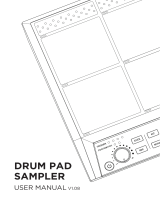
TABLE OF CONTENTS
INTRODUCTION ........................................................5
WELCOME TO THE SR18 DRUM MACHINE!.....5
GROUND RULES .................................................5
CONNECTION DIAGRAM.........................................8
TOP PANEL PHYSICAL LAYOUT ...........................9
GENERAL CONTROLS .......................................9
NAVIGATION BUTTONS .....................................10
MODE BUTTONS .................................................10
SETUP BUTTONS................................................11
TRANSPORT CONTROL BUTTONS...................11
REAR PANEL PHYSICAL LAYOUT.........................12
DISPLAY LAYOUT.....................................................13
BASICS .......................................................................14
HOW TO COMMUNICATE WITH THE SR18.......14
10 STEPS TO INSTANT GRATIFICATION
(SETUP AND CHECKOUT).............................15
THE INSTRUMENT LAYERS...............................16
PLAYBACK / RECORD BASICS .........................16
RECORDING PATTERNS .........................................21
STEPS TO RECORDING A PATTERN ................21
PRACTICE MODE ................................................21
RECORDING OTHER PARTS (PERCUSSION
AND BASS) .....................................................21
PATTERN PLAY MODE............................................22
PLAYING PATTERN SEQUENCES WITH THE
PADS ...............................................................22
RECORDING PATTERN SEQUENCES INTO A
SONG ..............................................................22
ASSIGNING PATTERNS TO THE PADS.............22
SELECTING, EDITING AND
CREATING DRUM SETS .....................................23
SELECTING A DRUM SET ..................................23
CREATING AND EDITING DRUM SETS .............23
EFFECTS..............................................................29
SAVING YOUR DRUM SETS...............................29
RECORD SETUP .......................................................30
PAGE 1: SELECT THE QUANTIZATION
VALUE (QUANTIZE SELECT) .............................30
PAGE 2: GATE.....................................................31
PAGE 3: SELECT THE SWING VALUE (SWING
SELECT)..........................................................31
PAGE 4: ENABLE CLICK AND SET RHYTHM
(CLICK SELECT)............................................31
PAGE 5: SET CLICK VOLUME (CLICK VOL).....31
PAGE 6: VELOCITY SENSITIVITY......................32
PAGE 7: BEAT VALUE........................................32
PAGE 8: NOTE VALUE........................................32
PAGE 9: PATTERN LENGTH ..............................33
PAGE 10: OFFSET A PATTERN OR DRUM
PART ...............................................................33
PAGE 11: NAME THE PATTERN (NAME) ..........33
EDITING PATTERNS – ERASE
FUNCTIONS .......................................................... 34
ERASING DRUM EVENTS WHILE
RECORDING ...................................................34
ERASING AN ENTIRE PATTERN........................34
ERASE ALL EVENTS PLAYED BY A
PARTICULAR DRUM PAD..............................34
ERASE ALL INSTRUMENT EVENTS IN SUB-
PATTERN ........................................................34
EDITING PATTERNS – COPY/SAVE
FUNCTIONS .......................................................... 35
SAVING A PATTERN...........................................35
COPYING A PATTERN ........................................35
APPENDING A PATTERN ...................................35
EDITING PATTERNS –
TRANSPOSITION..................................................36
PATTERN STEP EDITING (STEP
EDIT MODE) .........................................................36
ADDING A NEW DRUM TO A STEP ...................37
ERASE A DRUM SOUND FROM A STEP...........37
CHANGE A DRUM SOUND'S VOLUME IN A
GIVEN STEP ...................................................37
EXIT STEP EDIT MODE.......................................37
SONG MODE.............................................................. 38
PLAYING SONGS ................................................38
RECORDING A SONG IN REAL-TIME................39
MANUAL SONG CREATION (SONG STEP
EDIT MODE)....................................................40
SETTING SONG TEMPO .....................................42
INSERTING A TEMPO CHANGE IN A SONG.....42
CONTROLLING PLAYBACK POSITION.............43
LOOP A PATTERN INDEFINITELY.....................43
START FROM THE MIDDLE OF A SONG...........43
ERASING AN ENTIRE SONG..............................44
SAVING YOUR SONG .........................................44
APPEND A SONG................................................44
NAME A SONG (NAME) ......................................44
SYSTEM SETUP........................................................45
Page 1 / MIDI CHANNEL (MIDI CH) ....................45
Page 2 / RECEIVE MIDI NOTES (DRUM IN,
PERC IN, BASS IN).........................................45
Page 3 / TRANSMIT MIDI NOTES (DRUM OUT,
PERC OUT, BASS OUT).................................46
Page 4 / ASSIGN MIDI NOTE NUMBERS TO
DRUM PADS (NOTE)......................................46
Page 5 / ACCEPT EXTERNAL CLOCK VALUE
(CLOCK IN) ....................................................47
Page 6 / SEND CLOCK VALUE TO OTHER
DEVICES (CLOCKOUT)..................................47
Page 7 / MERGE MIDI IN WITH MIDI OUT
(MIDITHRU) ....................................................48
Page 8 / SELECT DRUM SETS VIA MIDI
PROGRAM CHANGES (PRG CHNG).............48
Page 9 / TEMPO SELECTION (TEMPO) ............49
Page 10 / MAP DRUM NOTES (NOTE MAP) .....49
PAGE 11 / MANUAL DRUMSET OVERRIDE
(SET MODE)...................................................51
Page 12 / LEDs (LEDS OFF) ..............................51
Page 13 / BACKLIGHT BRIGHTNESS
(BACKLITE) ...................................................51
Page 14 / BATTERY LEVEL (BATT LVL) ..........51
Page 15 / LOW BATTERY WARNING (LO
BATT) ..............................................................52
Page 16 / CHECK AVAILABLE MEMORY (MEM
FREE) ..............................................................52
Page 17 / SEND SONG AND PATTERN DATA
TO MIDI SYS EX STORAGE DEVICE (SEND
OUT MIDI?) .....................................................52
SENDING MIDI SYSEX SONG AND PATTERN
DATA TO THE SR18.......................................53
APPLICATIONS .........................................................54
MIDI SYNC APPLICATIONS................................54
STRATEGIES FOR ASSEMBLING PATTERNS
AND SONGS ...................................................55
UNDERSTANDING RHYTHMIC NOTATION .......56
MIDI IMPLEMENTATION CHART .......................... 57
FACTORY RESET......................................................58
KEY FEATURES ........................................................ 58
TECHNICAL SPECIFICATIONS ..............................58
f






















